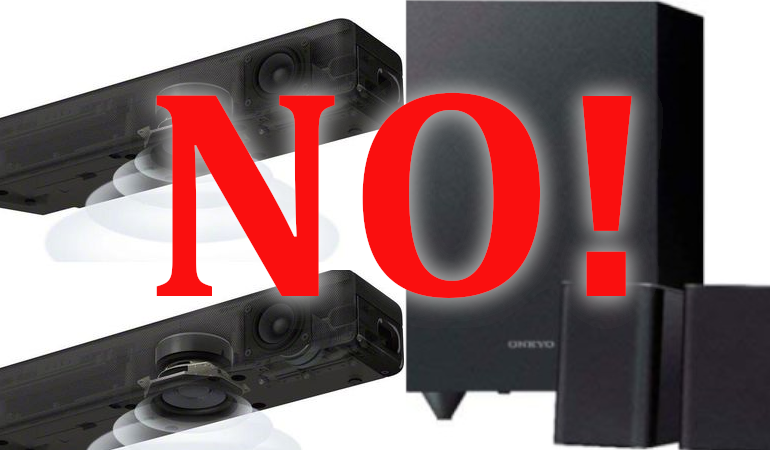Built-In Subwoofers – When Is A Subwoofer Not A Subwoofer?
If you’ve spent any time researching home theater speakers, you’ve seen pictures of subwoofers. Massive black boxes with huge drivers. They can dress them up but you can’t help but wonder if there is a more elegant solution. And then you come across a soundbar or Home Theater in a Box speaker system. They have either built-in subwoofers (soundbars) or diminutive boxes that they promise are subwoofers. Problem solved! Or is it? Let’s discuss.
There Is No Replacement For Displacement
We’ve explained how bass works before but here’s a refresher. Bass waves are extremely long. They also require a lot of power and driver surface area to create. That is why most subwoofers you see have big drivers (at least 10″ diameter, some much larger) with their own amps. These amps have a ton of power (often more than your entire AV receiver) just to move that big driver. The drivers themselves often have massive excursions (meaning that the driver can move very far out and in without damaging itself). All of this is to create those long bass waves.
To assist, many standalone subwoofers have large cabinets. As that driver moves in and out, it moves the air inside the cabinet. If the cabinet is ported, or has holes in it, the air moves in and out of the ports as well. If it is not, then the air behind the driver must compress inside the cabinet. Regardless of the type of cabinet (sealed or ported), the amount air behind the driver is engineered to support the movement of the driver. Too little air and the driver will bottom out. Too much and the driver won’t be able to move enough.
When you see built-in “subwoofers” or a super small box that is labeled “subwoofer,” ask yourself, “Is that really big enough and powerful enough to create really low bass?”

What Is Low Bass?
The full range of human hearing is 20Hz to 20kHz. Most home theater speakers of reasonable quality can play down to 80Hz. As we’ve discussed before, very little music dips lower than 30Hz. If you are just listening to music with your speakers, you maybe don’t need a subwoofer that can hit all the way to 20Hz. But if you want the lowest notes, you’ll want extension down to 30Hz. And very few speakers can play notes that low. That’s why you need a subwoofer. It may not need to play the infrasonic notes below 20Hz, but your speakers can’t do all the bass by themselves. They need help. Those built-in subwoofers and tiny boxes? They aren’t cutting it.

What Are Those Built-In “Subwoofers” Doing?
Most of the time, they are helping the rest of the speakers get down to 80Hz! Look at the size of the other speakers or drivers in the soundbar or packaged system. Are they tiny? They probably can’t get down to 80Hz by themselves. They need help. That built-in or tiny “subwoofer” isn’t giving you the low bass that real subwoofers provide. They are just adding to the extension of the diminutive speakers.
It is more accurate to call these built-in or tiny “subwoofers” bass modules. They are adding bass but they aren’t giving you what a subwoofer would. They may extend past 80Hz, but don’t expect 30Hz (much less 20Hz). Even then, the bass you experience is unlikely to be very linear.
Being Pedantic About Nomenclature
We think that these Home Theater in a Box systems and soundbars have a place. We think that their included bass modules (either standalone or built-in) are fine. Necessary even. We just hate when the marketing teams (we refuse to believe that it is the speaker designers) call them subwoofers. They objectively aren’t. They are Bass Modules. Call them that. We’ve seen 3″ drivers called “subwoofers” because they were larger than the other drivers in the speaker and were providing most of the bass. My dude, that’s not a subwoofer. Stop it.


